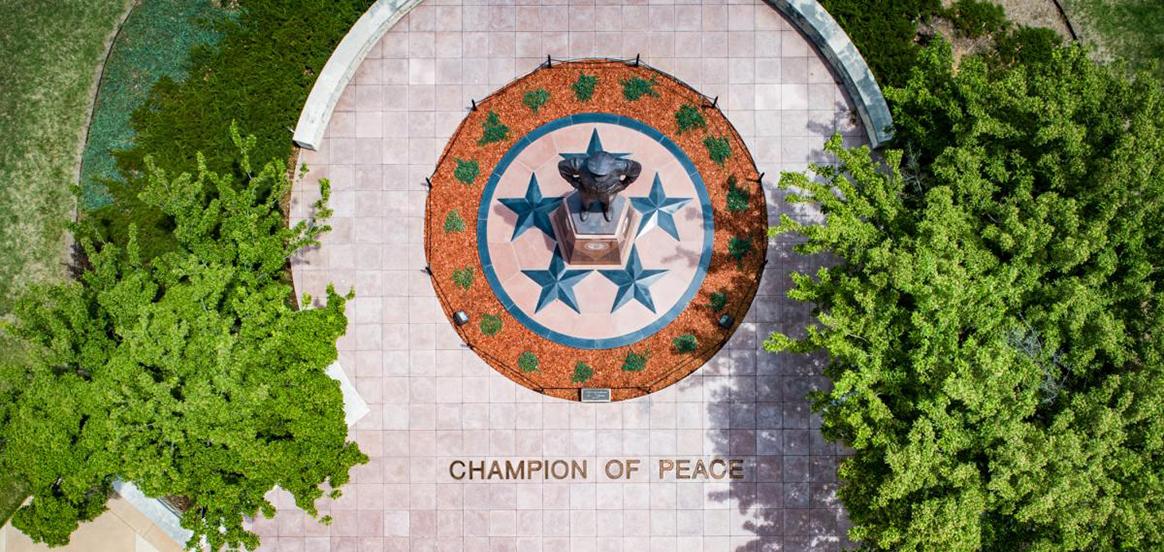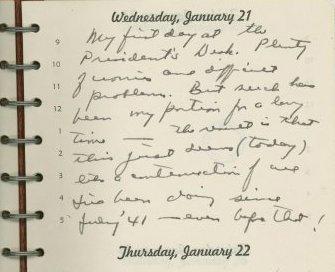| First Lady | Mamie Geneva Doud Eisenhower | |
| Dates of Presidency | January 20, 1953 - January 20, 1961 | |
| Presidency Number | 34 | |
| Number of Terms | 2 | |
| Political Party | Republican | |
| Vice President | Richard M. Nixon |
After 40 years of military service, Eisenhower devoted his presidency to waging peace. He strengthened the nation through alliances, promoting prosperity, and demonstrating moral leadership. In facing the threats of his time, he positioned the United States to win any conflict. He consistently sought peaceful positive alternatives to military action. In doing so, Eisenhower helped to establish the post-war order that guided American policy for more than 60 years. The Eisenhower Administration became known for its eight years of peace and prosperity. And, Dwight David Eisenhower became known as the Champion of Peace.
~ Dwight D. Eisenhower, January 21, 1953
Read additional Eisenhower Diaries
Eisenhower Administration Significant Dates
1953
January 1953: Neutralization of Formosa by Seventh Fleet ended.
March 5, 1953: Death of Josef Stalin, Premier of the Soviet Union.
March 12, 1953: The Department of Health, Education and Welfare is created.
April 22, 1953: States given title to offshore oil.
June 19, 1953: Julius and Ethel Rosenberg were executed for conspiracy to commit espionage under the U.S. Espionage Act of 1917.
July 27, 1953: Korean war ended with signing of armistice at Panmunjon calling for demilitarized zone and voluntary repatriation of prisoners. The 38th parallel is established as boundary between North and South Korea.
July 20, 1953: President Eisenhower signs the Small Business Act into law creating a new agency, the U.S. Small Business Administration (SBA).
August 19-22, 1953: Leftist government of Premier Mohammed Mossadegh in Iran is ousted and replaced with regime loyal to Shah Pahlevi.
Aug.-Sept. 1953: American prisoners of war in Korea repatriated.
December 4-8, 1953: President conferred at Bermuda with prime ministers of Britain and France on exchange of atomic information.
December 8, 1953: Eisenhower delivers his Atoms For Peace speech at the United Nations proposing an international atomic energy agency and peaceful development of nuclear energy.
1953-1954: Senator Joseph McCarthy, chairman of the Senate Permanent Investigation Subcommittee, conducts hearings on communist subversion in America and investigates communist infiltration of the Armed Forces.
1954
Jan. 21, 1954: First atomic submarine, U.S.S. Nautilus, launched, Groton, Connecticut.
Mar. 1, 1954: Five representatives wounded in House of Representatives by shots fired by Puerto Rican nationalists.
May 8-July 21, 1954: Geneva Conference on Indochina results in Geneva Accords partitioning Vietnam at the 17th Parallel and provides for unifying elections in two years.
May 7, 1954: French garrison at Dien Bien Phu surrenders to the Viet Minh.
May 13, 1954: St. Lawrence Seaway bill authorized joint construction by the United States and Canada.
May 17, 1954: Brown vs. Topeka Board of Education, Supreme Court rules that segregated schools are "inherently unequal" and unconstitutional.
June 25-29, 1954: President and Prime Minister Churchill conferred at Washington, DC, on world peace.
August 24, 1954: Communist party outlawed, but party membership not made a crime.
September 1, 1954: Social Security coverage extended to 10 million additional persons (farmers, professional people, etc.)
September 8, 1954: Southeast Asia Defense Treaty (SEATO) signed.
October 25, 1954: First telecast of a cabinet meeting.
December 2, 1954: Senator McCarthy was censured by the U.S. Senate.
1955
January 28, 1955: Congress approved presidential request to allow U.S. forces to defend Formosa against Communist aggression.
February 7, 1955: U.S. Seventh fleet helped evacuation of Communist-threatened Tachen Islands, near Formosa.
March 16, 1955: previously secret Yalta Conference papers released by State Department.
April 12, 1955: A vaccine developed by Dr. Jonas Salk is declared "safe, effective and potent" when introduced to combat the spread of poliomyelitis.
April 21, 1955: U.S. occupation of Germany ended; troops remained on contractual basis.
May 15, 1955: Big Four foreign ministers signed treaty restoring sovereignty to Austria.
May 31, 1955: Supreme Court reaffirmed principle of school integration, ordering gradual compliance by local authorities.
July 18-23, 1955: Geneva Four Power summit conference; Eisenhower submits "Open Skies" proposal allowing mutual air reconnaissance over military installations.
August 28, 1955: Murder of Emmett Till.
September 24, 1955: President Eisenhower suffered a heart attack.
October 27, 1955: Geneva meeting of Big Four foreign ministers.
December 5, 1955: AFL-CIO merger.
December 5, 1955: A boycott of city buses led by Martin Luther King, Jr. begins in Montgomery, Alabama. It lasts for 54 weeks.
1956
January 30, 1956: British Prime Minister Eden conferred with President Eisenhower at Washington, DC.
March 12, 1956: Manifesto issued by southern senators and representatives pledging use of all legal means to reverse Supreme Court integration ruling.
June 9, 1956: President Eisenhower underwent emergency ileitis operation.
June 29, 1956: Federal Highway legislation is signed authorizing funds for the interstate highway system.
July 16, 1956: The President's Council on Youth Fitness was established by President Eisenhower.
July 19, 1956: United States withdrew offers to finance construction of Aswan Dam in Egypt, precipitating Egyptian seizure of Suez Canal.
October-November 1956: Suez Canal Crisis. Israel invades Gaza Strip and the Sinai Peninsula, and British and French forces attack Egyptian bases around the Suez Canal.
October-November 1956: Armed revolt in Budapest, Hungary is crushed by Russian armed forces.
October 31, 1956: President Eisenhower, deploring Anglo-French-Israeli attack on Egypt, promised that United States would not support this action.
November 8, 1956: United States offered to admit Hungarian refugees of anti-Soviet revolt.
1957
January 10-11, 1957: Southern Christian Leadership Conference is formed by Martin Luther King, Jr. and 60 others.
March 9, 1957: Eisenhower Doctrine bill signed, authorizing use of U.S. forces to assist Middle East nations threatened by Communist aggression.
March 20-24, 1957: Bermuda Conference is held with British Prime Minister Harold MacMillan.
May 14, 1957: United States resumed military aid to Yugoslavia, halted during Tito's reconciliation with USSR.
June 1957: Controversial Supreme Court decisions on cases involving loyalty, subversive activities, and Communist Party membership.
June 1957: Prime Minister Kishi of Japan visited Washington, DC; joint American Japanese communique issued announcing withdrawal of American ground combat forces in Japan.
July 1957: United States proposed ban on nuclear tests after establishment of inspection system
July 1, 1957: The opening of the International Geophysical Year, a joint effort by scientists of 60 nations.
July 29, 1957: United States ratified International Atomic Energy Agency (proposed by President Eisenhower in 1953) to pool atomic resources for peaceful use.
September 9, 1957: The President signs the 1957 Civil Rights Act which seeks to protect voting rights.
September 19, 1957: First underground nuclear explosion, Nevada proving grounds.
September 24, 1957: President Eisenhower sent federal troops to scene of violence at Little Rock, Arkansas, High School to enforce integration of Negro students who had been barred by national guardsmen as ordered by Governor Orval Faubus.
October 4, 1957: Launching of first Soviet Sputnik set off demand for greater American efforts in defense and technology.
November 25, 1957: President Eisenhower suffered mild stroke, but recovered rapidly.
1957-1958: Business recession; over 5 million unemployed before reversal of downward trend.
1958
January 31, 1958: Launching of Explorer I; first American satellite.
May 1958: Vice President Nixon, on Latin American tour, attacked by anti-U.S. demonstrators.
July-October 1958: U.S. troops in Lebanon at request of Lebanese government threatened by United Arab Republic infiltration.
July-August 1958: Polar voyages of atomic submarines U.S.S. Nautilus and Skate.
July 15, 1958: Eisenhower orders U.S. Marines into Lebanon at the request of President Camille Chamoun.
July 29, 1958: President signed bill establishing National Aeronautics and Space Administration.
September 1958: Closing of schools in which integration had been ordered in Arkansas and Virginia.
September 2, 1958: Eisenhower signs the National Defense Education Act, providing loans for college students and funds to encourage young people to enter teaching careers.
November 1958 to early 1959: Khrushchev indicates that he plans to sign an early peace treaty with East Germany and he calls on the western powers to withdraw their forces from West Berlin. The Big Four meet to discuss Berlin and German reunification.
1959
January 1, 1959: Fidel Castro's guerilla forces overthrow the Batista regime in Cuba.
January 3, 1959: Alaska proclaimed 49th state.
March 18, 1959: President signed act admitting Hawaii as the 50th state.
April 25, 1959: St. Lawrence Seaway opens.
June 26, 1959: President Dwight Eisenhower and Queen Elizabeth II officially opened the St. Lawrence Seaway.
August 21, 1959: Hawaii becomes the 50th state.
September 15-27, 1959: Premier Khrushchev visits the United States.
1960
May 1, 1960: A U-2 reconnaissance plane piloted by Francis Gary Powers is shot down over the USSR.
May 16, 1960: The Paris Summit meeting collapses when Khrushchev demands an apology from President Eisenhower for the U-2 flights.
November 8, 1960: Senator John F. Kennedy defeats Vice President Richard M. Nixon in the presidential election.
1960: The Congo (Zaire) becomes independent from Belgium on June 30, 1960 and widespread violence leads to intervention by UN troops.
1961
January 17, 1961: President Eisenhower delivers his Farewell Address to the Nation warning of the "military-industrial complex."


